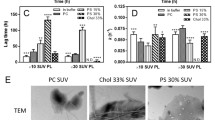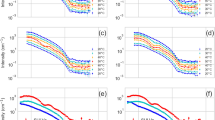Abstract
Fibrillar amyloid beta-protein (Aβ) is the major protein of amyloid plaques in the brains of patients with Alzheimer's disease (AD). The mechanism by which normally produced soluble Aβ gets fibrillized in AD is not clear. We studied the effect of neutral, zwitterionic, and anionic lipids on the fibrillization of Aβ 1-40. We report here that acidic phospholipids such as phosphatidic acid, phosphatidylserine, phosphatidylinositol (PI), PI 4-phosphate, PI 4,5-P2 and cardiolipin can increase the fibrillization of Aβ, while the neutral lipids (diacylglycerol, cholesterol, cerebrosides), zwitterionic lipids (phosphatidylcholine, phosphatidylethanolamine, sphingomyelin) and anionic lipids lacking phosphate groups (sulfatides, gangliosides) do not affect Aβ fibrillization. Aβ was found to increase the fluorescence of 1-acyl-2-[12-[ (7-nitro-2-1, 3-benzoxadiazol-4-yl) amino] dodecanoyl]-sn-glycero-3-phosphate (NBD-PA) in a concentration-dependent manner, while no change was observed with 1-acyl-2-[12-[(7-nitro-2-1, 3-benzoxadiazol-4-yl) amino] dodecanoyl]-sn-glycero-3-phosphoethanolamine (NBD-PE). Under similar conditions, other proteins such as apolipoprotein E, gelsolin and polyglutamic acid did not interact with NBD-PA. The order of interaction of amyloid β-peptides with NBD-PA was Aβ 1-43 = Aβ 1-42 = Aβ 17-42 > Aβ 1-40 = Aβ 17-40. Other Aβ peptides such as Aβ 1-11, Aβ 1-16, Aβ 1-28, Aβ 1-38, Aβ 12-28, Aβ 22-35, Aβ 25-35, and Aβ 31-35 did not increase the NBD-PA fluorescence. These results suggest that phosphate groups, fatty acids, and aliphatic amino acids at the C-terminus end of Aβ 1-40/Aβ 1-42 are essential for the interaction of Aβ with anionic phospholipids, while hydrophilic Aβ segment from 1-16 amino acids does not participate in this interaction. Since positively charged amino acids in Aβ are necessary for the interaction with negatively charged phosphate groups of phospholipids, it is suggested that Lys28 of Aβ may provide anchor for the phosphate groups of lipids, while aliphatic amino acids (Val-Val-Ile-Ala) at the C-terminus of Aβ interact with fatty acids of phospholipids.
Similar content being viewed by others
REFERENCES
Wisniewski, H. M., Sinatra, R. S., Iqbal, K., and Grundke-Iqbal, I., 1981. Neurofibrillary and synaptic pathology in the aged brain, Vol. 1, pages 105–142, in Johnson, J. E. Jr. (ed.), Aging and Cell Structure, Plenum Publishing Corporation, New York.
Masters, C. L., Simms, G., Weinman, N. A. Multhaup, G., Mc-Donald, B. L., and Beyreuther, K. 1985. Amyloid plaque core protein in Alzheimer' disease and Down' Syndrome, Proc. Natl. Acad. Sci. USA. 82:4245–4249.
Miller, D. L., Papayannopoules, I. A., Styles, J., Bobin, S. A., Lin, Y. Y., Biemann, L. K., and Iqbal, K. 1993. Peptide compositions of the cerebrovascular and senile plaque core amyloid deposits of Alzheimer' disease, Arch. Biochem. Biophys. 301:41–52.
Roher, A. E., Lowenson, J. D., Clarke, S., Wolkow, C., Wang, R., Cotter, R. J., Reardon, I. M., Zurcher-Neely, H. A., Heinreikson, R. L., Ball, M. J., and Greenberg, B. D. 1993. Structural alterations in the peptide backbone of beta-amyloid core protein may account for its deposition and stability in Alzheimer' disease, J. Biol. Chem. 268:3072–3083.
Iwatsubo, T., Odaka, A., Suzuki, N., Mizusawa, H., Nukina, N., and Ihara, Y. 1994. Visualization of A??42 (43) and A??(40) in senile plaques with end-specific A??monoclonals: Evidence that an initially deposited species is A??42 (43), Neuron 13:45–53.
Hilbich, C., Kisters-Woike, B., Reed, J., Masters, C. L., and Beyreuther, K. 1991. Aggregation and secondary structure of synthetic amyloid beta A4 peptides of Alzheimer' disease, J. Mol. Biol. 218:149–163.
Lorenzo, A., and Yankner, B. A. 1994. ?-amyloid neurotoxicity requires fibril formation and is inhibited by Congo red, Proc. Natl. Acad. Sci. U.S.A. 91:12243–12247.
Iversen, L. L., Mortishire-Smith, R. J., Pollack, S. J., and Shearman, M. S. 1995. The toxicity in vitro of ?-amyloid protein, Biochem. J. 311:1–16.
Jarrett, J. T., and Lansbury, P. T., Jr. 1993. Seeding “One-Dimensional Crystallization” of amyloid: A pathogenic mechanism in Alzheimer' disease and Scrapie, Cell 73:1055–1058.
Bush, A. I., Pettingell, W. H., Multhaup, G., Paradis, M., Vonsaltel, J., Gusella, J. F. Beyreuther, K., Masters, C. L., and Tenzi, R. E. 1994. Rapid induction of Alzheimer' A??amyloid formation by zinc, Science 265:1464–1467.
Mantyh, P. W., Ghilardi, J. R., Rogers, S., DeMaster, E., Allen, C. J., Stimson, E. R., and Maggio, J. E. 1993. Aluminum, iron, and zinc ions promote aggregation of physiological concentrations of ?-amyloid peptide, J. Neurochem. 61:1171–1174.
Miatto, O., Gonzalez, G., Bounanno, F., and Growdon, J. H. 1986. In vitro 31P NMR spectroscopy detects altered phospholipid metabolism in Alzheimer' disease, Can. J. Neurosci. 13: 535–539.
Stokes, C. E., and Hawthorne, J. N. 1987. Reduced phosphoinositide concentrations in anterior temporal cortex of Alzheimer-diseased brains, J. Neurochem. 48:1018–1021.
Pettegrew, J. W., Moossy, J., Withers, G., McKeag, D., and Panchalingam, K. 1988. 31P nuclear magnetic resonance study of the brain in Alzheimer' disease, J. Neuropathol. Exp. Neurol. 47:235–248.
Nitsch, R. M., Blusztajn, J. K., Pittas, A. G., Slack, B. E., Growdon, J. H., and Wurtman, R. J. 1992. Evidence for a membrane defect in Alzheimer' disease brain, Proc. Natl. Acad. Sci. USA 89:1671–1675.
Ginsberg, L., Rafique, S., Xuereb, J. H., Rapoport, S. I., and Gershfeld, N. L. 1995. Disease and anatomic specificity of ethanolamine plasmalogen deficiency of Alzheimer' disease brain, Brain Res. 698:223–226.
Wells, K., Farooqui, A. A., Liss, L., and Horrocks, L. A. 1995. Neural membrane phospholipids in Alzheimer' disease. Neurochem. Res. 20:1329–1333.
Farooqui, A. A., Rapoport, S. I., and Horrocks, L. A. 1997. Membrane phospholipid alterations in Alzheimer' disease: Deficiency of ethanolamine plasmalogen, Neurochem. Res. 22:523–527.
Guan, Z., Wang, Y., Cairns, N. J., Lantos, P. L., Dallner, G., and Sindelar, P. J. 1999. Decrease and structural modifications of phosphatidylethanolamine plasmalogen in the brain with Alzheimer disease, J. Neuropathol. Exp. Neurol. 58:740–747.
Chia, L. S., Thompson, J. E., and Moscarello, M. A. 1984. X-ray diffraction evidence for myelin disorder in brain from human with Alzheimer' disease, Biochim. Biophys. Acta 775:308–312.
Zubenko, G. S. 1986. Hippocampal membrane alteration in Alzheimer' disease, Brain Res. 385:115–121.
Dawson, R. M. C., and Eichberg, J. 1965. Diphosphoinositide and triphosphoinositide in animal tissues: extraction, estimation and changes post mortem. Biochem. J. 96:634–643.
Simons, M., Keller, P., De Strooper, B., Beyreuther, K., Dotti, C. G., and Simons, K. 1998. Cholesterol depletion inhibits the generation of beta-amyloid in hippocampal neurons, Proc. Natl. Acad. Sci. USA 95:6460–6464.
Perichon, R., Moser, A. B., Wallace, W. C., Cunningham, S. C., Roth, G. S., and Moser, H. W. 1998. Peroxisomal disease cell lines with cellular plasmalogen deficiency have impaired muscarinic cholinergic signal transduction activity and amyloid precursor protein secretion, Biochem. Biophys. Res. Commun. 248:57–61.
McLaurin, J., Franklin, T., Chakrabarty, A., and Fraser, P. E. 1998. Phosphatidylinositol and inositol involvement in Alzheimer amyloid-beta fibril growth and arrest, J. Mol. Biol. 278:183–194.
Chauhan, A., Chauhan, V. P. S., Brockerhoff, H. and Wisniewski, H. M. Effect of amyloid beta-protein on membrane properties. Pages 431–439, in Corain, B., Iqbal, K. Nicolini, M., Winblad, B., Wisniewski, H., and Zatta, P. (eds.), Alzheimer' disease: Advances in Clinical and Basic Research, John Wiley & Sons, Inc., New York.
Muller, W. E., Eckert, G. P., Scheuer, K., Cairns, N. J., Maras, A., and Gattaz, W. F. 1998. Effects of beta-amyloid peptides on the fluidity of membranes from frontal and parietal lobes of human brain: High potencies of A??1-42 and A??1-43, Amyloid 5:10–15.
Chauhan, A., Chauhan, V. P. S., Singh, S. S., Brockerhoff, H., and Wisniewski, H. M. 1994. Amyloid ?-protein induces membrane fusion. Structure-function studies, Neurobiol. Aging 15:555.
Pillot, T., Goethals, M., Vanloo, B., Talussot, C., Brasseur, R., Vandekerckhove, J., Rosseneu, M., and Lins, L. 1996. Fusogenic properties of the C-terminal domain of the Alzheimer beta-amyloid peptide, J. Biol. Chem. 271:28757–28765.
Terzi, E., Holzemann, G., and Seelig, J. 1997. Interaction of Alzheimer beta-amyloid peptide (1-40) with lipid membranes, Biochemistry 36:14845–14852.
LeVine, III, H. 1993. Thioflavin T interaction with synthetic Alzheimer' disease ?-amyloid peptides: Detection of amyloid aggregation in solution, Protein Sci. 2:404–410.
Chauhan, A., Chauhan, V. P. S., Wegiel, J., and Wisniewski, H. M. 1996. Impact of normal and heat-inactivated serum on in vitro aggregation and fibrillization of synthetic amyloid betaprotein, Alzheimer' Res. 2:243–248.
Chauhan, V. P. S., and Brockerhoff, H. 1984. Ca (phosphatidate)2 can traverse liposomal bilayers, Life Sci. 35:1395–1399.
Halverson, K., Fraser, P. E., Kirschner, D. A., and Lansbury, P. T., 1990. Molecular determinants of amyloid deposition in Alzheimer' disease: conformational studies of synthetic ?-protein fragments, Biochemistry 29:2639–2644.
Lansbury, P. T., Costa, P. R., Griffiths, J. M., Simon, E. J., Auger, M., Halverosn, K. J., Kocisko, D. A., Hendsch, Z. S., Ashburn, T. T., Spencers, R. G. S., Tidor, B., and Griffin, R. G. 1995. Structural model for the ?-amyloid fibril based on interstrand alignment of an anti-parallel-sheet comprising a C-terminal peptide, Nature Struct. Biol. 2:990–997.
Lomakin, A., Chung, D. S., Benedek, G. B., Kirschner, D. A., and Teplow, D. B. 1996. Detection of nuclei, and quantitation of rate constants on the nucleation and growth of amyloid ?-protein fibrils, Proc. Natl. Acad. Sci. 93:1125–1129.
Jain, S. K. 1984. The accumulation of malonyldialdehyde, a product of fatty acid peroxidation, can disturb aminophospholipid organization in the membrane bilayer of human erythrocytes, J. Biol. Chem. 259:3391–3394.
Martin, S. J., Reutelingsperger, C. P., McGahon, A. J., Rader, J. A., van Schie R. C., Laface, D. M., and Green, D. R. 1995. Early redistribution of plasma membrane phosphatidylserine is a general feature of apoptosis regardless of the initiating stimulus: Inhibition by over expression of Bcl 2 and Abl, J. Exp. Med. 182:1545–1556.
Behl, C., Davis, J. B., Lesley, R., and Schubert, D. 1994. Hydrogen peroxide mediates amyloid ?-protein toxicity, Cell 77:817–827.
Smith, M. A., Hirai, K., Pappolla, M. A., Harris, P. L. R., Siedlak, S. L., Tabaton, M., and Perry, G. 1998. Amyloid-? deposition in Alzheimer transgenic mice is associated with oxidative stress, J. Neurochem. 70:2212–2215.
Cotman, C. W., and Anderson, A. J. 1995. A potential role for apoptosis in neurodegeneration and Alzheimer' disease, Mol. Neurobiol. 10:19–45.
LeBlanc, A. 1997. Apoptosis and Alzheimer' disease. Pages 57–71, in Wasco, W. and Tanzi, R. E. (eds.), Molecular Mechanism of Dementia, Human Press, New Jersey.
Author information
Authors and Affiliations
Rights and permissions
About this article
Cite this article
Chauhan, A., Ray, I. & Chauhan, V.P.S. Interaction of Amyloid Beta-Protein with Anionic Phospholipids: Possible Involvement of Lys28 and C-Terminus Aliphatic Amino Acids. Neurochem Res 25, 423–429 (2000). https://doi.org/10.1023/A:1007509608440
Issue Date:
DOI: https://doi.org/10.1023/A:1007509608440




